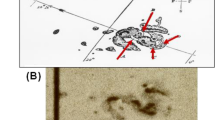Abstract
Interplanetary-scintillation observations of the radio source B0531+194 (J0534+1927) obtained over a wide range of elongations at 111 MHz using the Big Scanning Antenna of the Lebedev Physical Institute are presented. Near the Sun, the temporal spectra of the scintillations have a two-component form, corresponding to the superposition of refractive and diffractive scintillations that is characteristic of the saturated regime. A method for estimating the angular size of the scintillating component based on measurement of the break frequency in the diffractive part of the scintillation spectrum is presented. The scintillating component as a fraction of the total flux can be determined using the maximum scintillation index. The angular size of the scintillating component in B0531+194 is found to be 0.24″ ± 0.05″, and the ratio of the fluxes in the core and halo to be roughly one-third. The flux density in the compact radio component is 5 Jy. The estimated parameters of the angular structure of the source are compared with observations at other frequencies.
Similar content being viewed by others
References
V. I. Vlasov, Sov. Astron. 23, 55 (1979).
V. I. Shishov and T. D. Shishova, Sov. Astron. 22, 235 (1978).
V. I. Shishov and T. D. Shishova, Sov. Astron. 23, 345 (1979).
A. L. Bobeiko, V. P. Bovkun, S. Ya. Braude, and A. V. Men’, Antenny 26, 121 (1978).
V. H. Rumsey, Radio Sci. 10, 107 (1975).
M. Marians, Radio Sci. 10, 115 (1975).
V. S. Artyukh, Tr. Fiz. Inst. Lebedeva 189, 223 (1988).
A. P. Marscher, in Superluminal Radio Sources, Ed. by T. J. Pearson and J. A. Zensus (Cambridge Univ. Press, Cambridge, New York, 1987), p. 280.
Solar-Terrestrial Environment Laboratory, Nagoya University. http://www.stelab.nagoya-u.ac.jp.
S. K. Glubokova, A. V. Glyantsev, S. A. Tyul’bashev, et al., Geomagn. Aeron. 51, 794 (2011).
Laboratory of X-Ray Solar Astronomy, Phys. Inst. of RAS, TESIS Project. http://www.tesis.lebedev.ru/ru/sun_flares.html.
NRAO VLA Archive Survey Images Page. http://www.aoc.nrao.edu/~vlbacald/.
R. A. Perley, Astron. J. 87, 859 (1982).
S. Jeyakumar, D. J. Saikia, A. Pramesh Rao, and V. Balasubramanian, Astron. Astrophys. 362, 27 (2000).
E. B. Fomalont, L. Petrov, D. S. MacMillan, et al., Astron J. 126, 2562 (2003).
A. E. Wehrle, D. D. Morabito, and R. A. Preston, Astron. J. 89, 336 (1984).
L. Petrov, T. Hirota, M. Honma, et al., Astron. J. 133, 2487 (2007).
V. S. Artyukh and T. V. Smirnova, Sov. Astron. Lett. 15, 344 (1989).
NASA/IPAC Extragalactic Database. http://ned.ipac.caltech.edu/.
P. K. Manoharan, Astrophys. J. 751, 128 (2012).
Author information
Authors and Affiliations
Corresponding author
Additional information
Original Russian Text © A.V. Glyantsev, S.A. Tyul’bashev, I.V. Chashei, V.I. Shishov, 2013, published in Astronomicheskii Zhurnal, 2013, Vol. 90, No. 7, pp. 557–564.
Rights and permissions
About this article
Cite this article
Glyantsev, A.V., Tyul’bashev, S.A., Chashei, I.V. et al. Determining source angular sizes from interplanetary-scintillation observations in the saturated regime. Astron. Rep. 57, 509–516 (2013). https://doi.org/10.1134/S1063772913070032
Received:
Accepted:
Published:
Issue Date:
DOI: https://doi.org/10.1134/S1063772913070032




